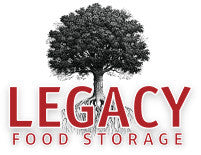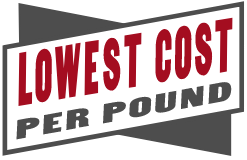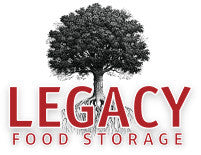A Brief Education on Food Storage Shelf Life
When a survival situation arises and you go to your cupboard to break out the emergency food you have had stashed away for ages, do you want to be anxiously sniffing it and crossing your fingers that it’s still good and not going to make you very sick? I’m guessing you probably want to be able to trust that the food storage you have spent so much time and effort collecting is going to last as long as it is advertised to.
A reliably long shelf life—specifically, 25 years or more—is vital in food storage products for several reasons. Long shelf lives that you can trust give you peace of mind knowing you have provided for your family in the event of an emergency, and that you have done so safely. In addition, investing in food storage with a 25-year shelf life can be cheaper in the long run because it saves you having to replace food storage that has gone bad. It also makes your life a little easier without having to deal with the hassle of frequent food storage rotation.
As you research different emergency food options, you’ll find that many food storage companies advertise a 25-year shelf life. Before you make a pricey investment, keep a few things in mind. Many companies use the claim of a 25-year shelf life as a nice-sounding marketing tool without having any real evidence to back it up. Watch out for these companies and make sure you are getting a product that will perform as well as it should. You can do this by becoming educated on the factors that affect the shelf life of emergency food: ingredients, preservation, packaging, and storage.
Factors that Affect Shelf Life
Ingredients
It’s a simple fact of nature: some foods last longer than others. Case in point: potatoes versus fresh greens. (I swear we had the same bag of potatoes in the pantry the whole time I was growing up. In contrast, I buy a bag of fresh greens at the grocery store, and if I haven’t eaten it up within a few days, I end up with a pretty slimy salad.) There are wide variations in the shelf life of different ingredients that make up food storage, and it’s important to keep these in mind so that you can judge how long your food storage will truly last—outside of marketing claims.
Brigham Young University has been conducting research on various food storage items and determining which types of foods last for long periods of time. Here is a brief summary of their findings:
- Salt, granulated sugar, and baking soda have no currently known shelf life if they are in their original containers and stored correctly.
- Wheat and rice stored in foil pouches, cans, or buckets have the potential to last 30 years or more.
- Powdered milk, oats, instant potatoes, beans, dried apples, and macaroni stored in foil pouches with oxygen absorbers or in cans can last 15 to 30 years when stored correctly.
- Wet-pack canned foods last five years at most, depending on their ingredients. Yeast and cooking oil typically last 1 ½ years.
- Powdered eggs last about one year.
For more information, you can check out more research here.
Preservation and Packaging
The way a survival food is preserved and packaged is monumental when considering its shelf life. Following are some common food storage methods and their relative shelf lives.
- Meals-Ready-to-Eat (MRE’s) are exactly what they sound like. You open them up and dig in. These types of emergency food meals typically have a shelf life of only three years.
- Wet-packed canned foods, as mentioned above, typically have a shelf life of five years at best. Canned foods with acidic ingredients like tomatoes last for an even shorter amount of time because they can begin to corrode the cans.
- Canned dry foods typically have a long shelf life, depending on the type of food stored in them (see above), and especially if sealed with oxygen absorbers.
- Freeze-dried and dehydrated foods have a similarly long shelf life because of their particular fitness to last long periods of time. Both the freeze-drying process and the dehydration process remove large amounts of moisture from the food, keeping microorganisms from spoiling the food.
Whatever the packaging, food should be stored with a residual oxygen level of below 2%. Nitrogen flushes and oxygen absorbers can help to achieve this goal. Find out if this is a practice employed by the food storage company you are researching.
Storage
The last factor in the shelf life of any emergency food is its storage conditions. When selecting a place to store your emergency food, remember the four components of a good storage area: low temperature, low moisture, low oxygen, and low light. If your food storage is exposed to too much of any of these, it can cause the food to lose nutrients, have off flavors, or spoil. Aim for your food to be consistently somewhere below room temperature (garages and attics are not a good idea because of the high summertime temperatures they reach), and try to keep it out of unnecessary moisture and light. The oxygen level should be taken care of by the packaging if it is trustworthy.
Becoming familiar with the factors that influence shelf life will help you make wiser decisions when buying emergency food. Selecting food like Legacy Premium’s that is proven to last for 25 years saves you money and hassle, and it allows you to rest easy knowing that you can trust your food storage to still be nutritious and tasty when the time comes for you to use it. Make an investment in your family by storing food with a shelf life you can rely on.
The post A Brief Education on Food Storage Shelf Life appeared first on Buy Emergency Food.
Tags
- All
- 25 year food
- 25 year shelf life food
- 72 hour kit
- Best food storage types
- Best long-term food storage
- Blizzard preparedness
- Budgeting
- canning
- Certified GMO-free Emergency foods
- Certified GMO-free foods
- Coffee
- Comparison of emergency food methods
- Composting tips
- Dangers of genetically modified foods
- dehydrated food
- Edible Wild Plants
- emergcy preparedness
- Emergency Cooking
- Emergency Food
- Emergency food Christmas gifts
- emergency food storage
- Emergency Food Supply
- Emergency food supply recommendations
- Emergency Planning
- Emergency Preparedness
- Emergency preparedness advice
- emergency preparednesss
- Emergency Supplies
- Emergency supplies checklist
- Emergency Survival
- emergency survival gear
- Emergency survival kit checklist
- Emergency Survival skills
- exercise
- Family emergency preparedness
- Family emergency preparedness plan
- Family Preparedness
- Food Storage
- Food storage 25 year shelf life
- Food storage amounts
- Food storage Christmas
- Food storage containers long term
- Food Storage Secrets
- Food storage serving size
- Food storage types compared
- freeze dried food
- Freeze dried food storage
- freeze dried meats
- Freeze-dried emergency food storage
- Fruit Trees
- Gardening
- Getting Started
- Gluten-free food Storage
- Gourmet emergency food
- Healthy food storage
- How much emergency food to store
- Improved emergency preparedness
- Jared Markin
- Jared Matkin
- Legacy Premium
- Lessons learned from Hurricane Sandy
- Lessons learned from natural disasters
- long-term food storage
- Long-term Food Storage Guidelines
- Long-term Food Storage tips
- Long-term water storage
- Mental Emergency Preparedness
- Mental toughness
- Money-saving tips
- Natural disaster planning
- Natural Disasters
- Perfect Christmas gifts
- Pet Emergency preparedness checklist
- Pet Emergency preparedness kit
- Pet Emergency Survival tips
- Pets and Emergency Preparedness
- Plant Foraging
- portable solar panels
- portable solar power
- portable water filters
- protein drinks
- Risk of genetic modification
- Seed saving and storage
- Seed saving guide
- Self-reliance
- Self-reliant practices
- Shelf Life
- Solar Cooking
- Solar Ovens
- Special Dietary needs
- Stranded in a car in a blizzard
- Survival food
- Survival Gear
- survival kit
- Survival kits
- Survival Ovens
- Survival Skills
- survivalist gear
- suvival kit
- Tree Pruning tips
- Tree Trimming basics
- unique ideas
- water bottle with filter
- water filter
- water filter straw
- water filters
- Water Filtration
- water pitcher with filter
- water pitchers with filters
- Water purification
- Wild Food Foraging
- Winter composting
- Winter driving
- Winter preparedness tips
- Winter storm preparedness tips
- Winter Survival







